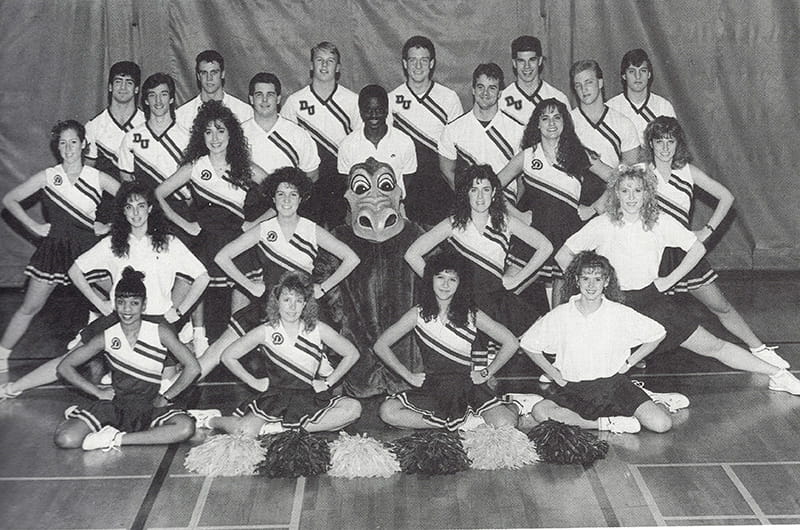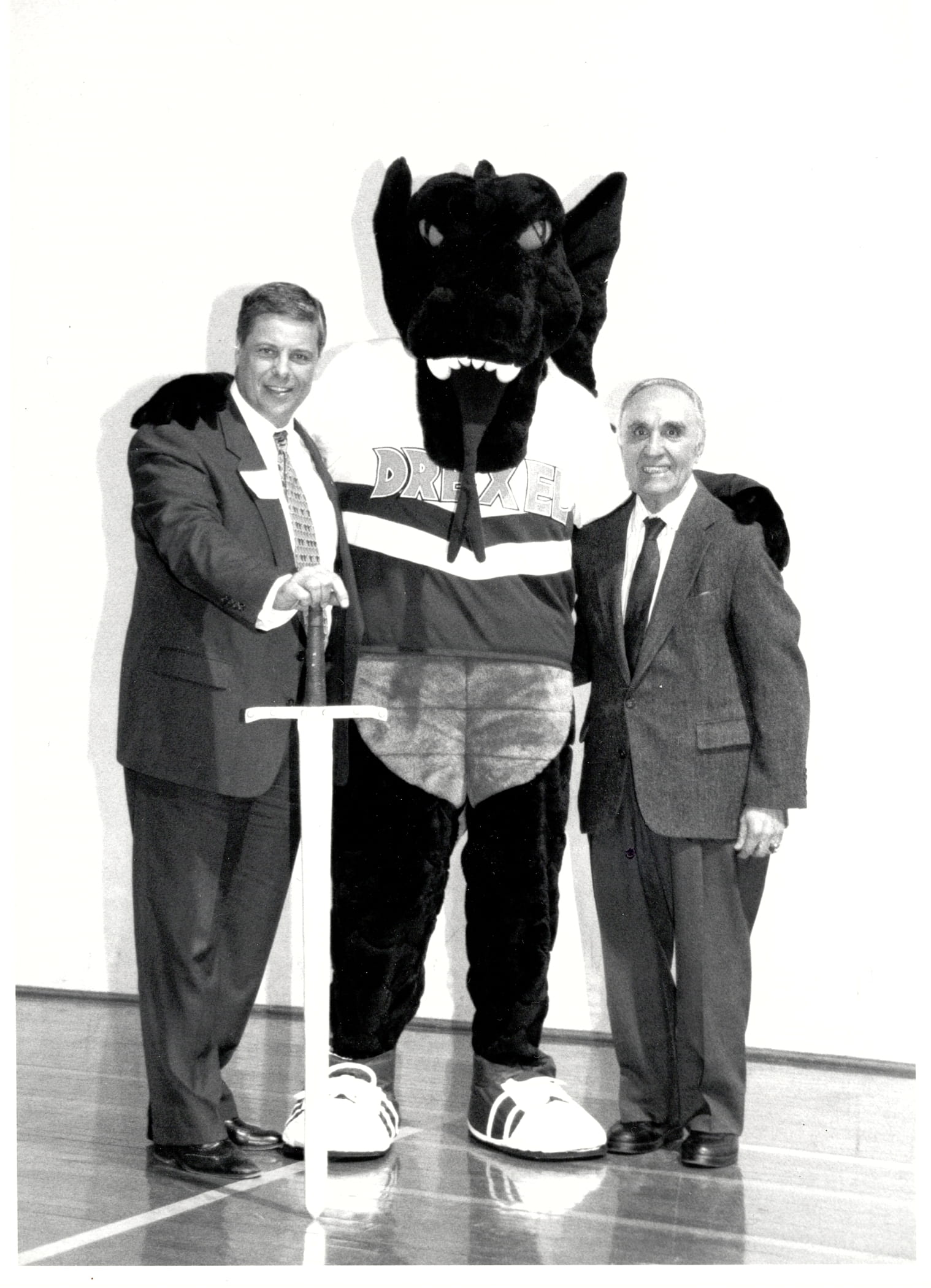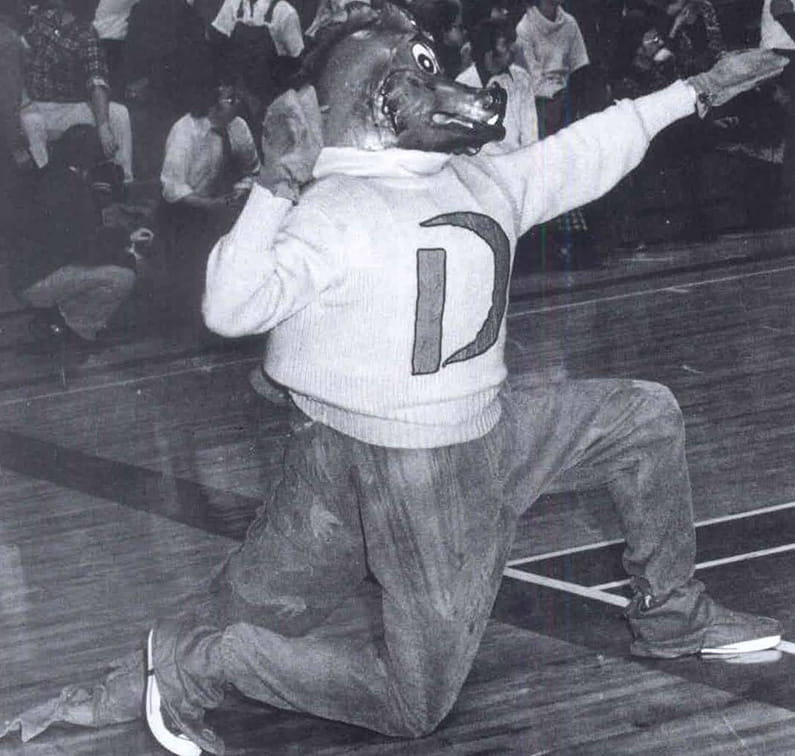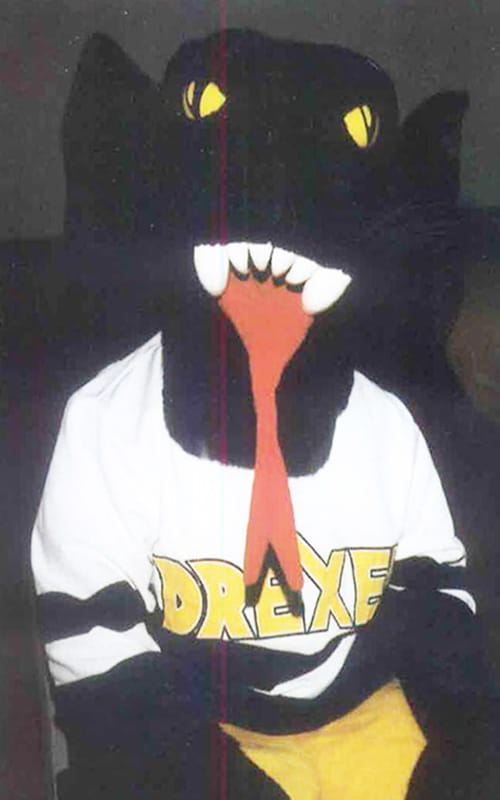Hidden Treasures: The 90-Year Evolution of the Drexel Dragon

- Drexel Selects New, World-Class Life Sciences Building at 3201 Cuthbert Street for Medical Research Operations
- Dragons Deliver: Drexel’s Annual Holiday Drives Support Military and Local Families
- Heard Around Campus — December 2025
- Celebrating a Year of Milestones, Achievements and Transformative Change

Today, Drexel University’s mascot is a dragon named Mario — but he wasn’t always called Mario, and he wasn’t always a dragon.
Mario has only been “Mario,” or “Mario the Magnificent,” since 1997, when that year’s graduating class gifted the University a new dragon mascot with a new name. The name was chosen to honor Mario V. Mascioli ’45, an alumnus who never missed a men’s basketball game for more than 20 years while he was on Drexel’s board of trustees, a member of the Drexel 100 and chairman and governor emeritus on the board of governors of the Drexel Alumni Association.
And the Drexel Dragon has only been a Drexel Dragon since 1928 — before that, teams from the then-Drexel Institute of Art, Science and Industry were actually called “The Engineers.” That changed because, as an April 16, 1928 article of The Triangle, Drexel’s student newspaper, recounted, the non-engineering students didn’t necessarily want to be called “The Engineers.” Before and even after the name was switched to “the Dragons” and “the Drexel Dragons,” teams were also referred to as “the Drexelites” and “the Blue & Gold.” Up until the 1980s, “Dragonettes” was even used for the women’s athletics teams.

But in the 90 or so years since the dragon was hatched at Drexel, the look of the mascot has changed a lot. Just take a look at these photos from University Archives that demonstrate just how much Mario has evolved in the past 90 years.
For the past couple of decades, the Drexel Dragon has attended various sports, alumni and other University events as — spoiler alert! — a human being in a mascot costume. But in the beginning years of the Drexel Dragon, that wasn’t the case.
In 1929, the Dragon made its debut at a pep rally before a big game, but as The Triangle noted a year later, it had to be rehabilitated:
Old bones were broken away and new ones installed (this time of steel); its head was remodeled according to the 1930 fashion; a new set of teeth was installed. ... A small jar of titanium tetrachloride has been placed in the head with tubes leading to the nostrils. When the liquid comes in contact with the air a dense smoke is formed, resembling the traditional fiery breath of the historic monsters. The scaly body has been slightly altered by a new coat of paint in order to meet the demands of the coming onslaught.

A few years later, this smoke-emitting Dragon was updated to a lighter, safer version of a dragon, made of cloth, that Drexel students could walk under, and alongside, to march it down the street before a big game.
A few decades later, it seems as though the Drexel Dragon was being created, rather than acted out. In 1962, for example, one was made out of papier-maché by a group of creative and enterprising fraternity brothers for a special event. In 1970, another inanimate Dragon rode around on the back of a car during Drexel’s Homecoming parade.
By the end of the decade, however, the Drexel Dragon mascot became animated — a tradition that continues to this day, with Drexel students stepping in to Mario’s claws. In the late ‘70s and early ‘80s, the Dragon wore a collegiate sweater featuring a big Drexel “D” over a jumpsuit-like costume with a hard mask, as seen in publicity photos from the newly opened Dragon’s Den in 1979 and photos at the gym. This Dragon had eyebrows and a Mohawk-like horn (both of which would disappear at a later point). The shoes of the student could be seen under the dragon’s feet (which would later change), and the hands of the student were covered in gloves (Dragon claws would later be incorporated into the outfit itself).

By the mid-‘90s, however, the Mohawk and eyebrows were gone, though a line of thick spikes were added to the side of the Dragon’s face, under his newly incorporated ears. These photos, which are in color now, show the Dragon in shades of light and royal blue (rather than today’s navy) and wearing a yellow (rather than today’s gold) shirt with “Drexel Dragon” printed on the front, under which a lighter blue belly was exposed. This costume, which is housed in the Daskalakis Athletic Center, still resembled a loose velour jumpsuit, with small wings that were safety-pinned on the back (today they’re worn like a backpack) and claws big enough for the student to wear his or her own shoes inside. The wearer would be able to see through the mouth of the dragon in the special head part of the costume; today, the mascot’s eyes are used to see.
In 1997, when the Drexel Dragon was officially named Mario, he was outfitted in the Drexel navy and gold of today. Mario was more of a fitted costume than loose jumpsuit, and had picked up some shoes along the way. Now, his physicality included slotted snake-like eyes, a big, forked, red tongue, big ears on the side of his face and a bright gold belly.

Five years later, Mario had gotten a new makeover, this time with huge gold spikes down his back and tail that matched his claws. Sometimes he wore sneakers, sometimes he didn’t. The snake-like tongue remained, but the eyes became more cartoonish, the face became more yellow around his mouth and nose and the ears were removed.
The 2008 Mario starts to look more like the 2018 Mario — mostly navy, with cartoonish eyes, navy and gold wings that have slightly changed, a tongue that stays in his mouth and a more understated set of gold spikes on his back and tail. He still went barefoot and sans pants — though the Mario of today usually wears sneakers and a white Drexel basketball uniform with both a top and a bottom covering his gold belly.
As you can see through these photos, today’s Mario looks very different compared to the Mario of the late ‘90s and the Drexel Dragon of the decades before it. Next time you see Mario on campus, feel free to tell him you like his “new” look!
This story was published in the summer 2018 issue of Drexel Quarterly.Drexel News is produced by
University Marketing and Communications.
